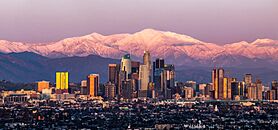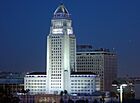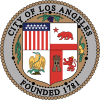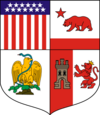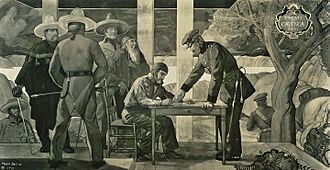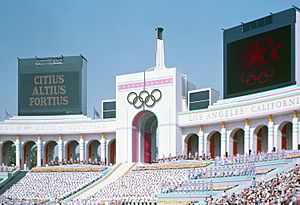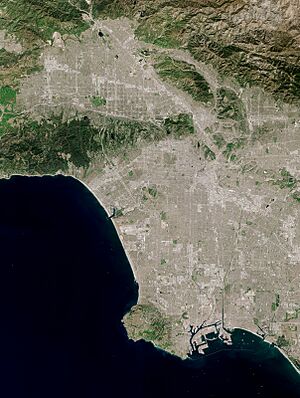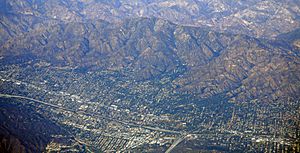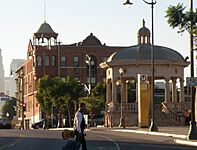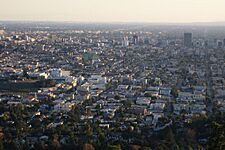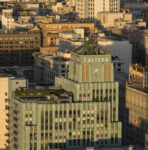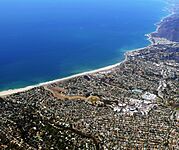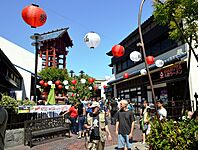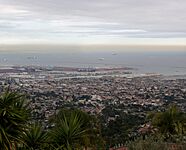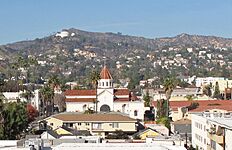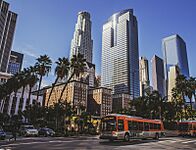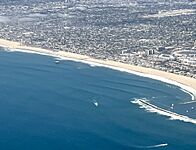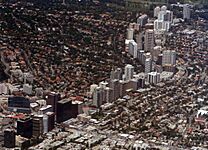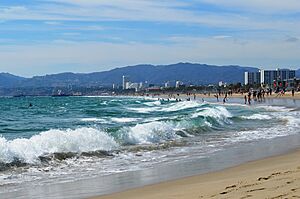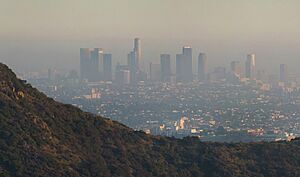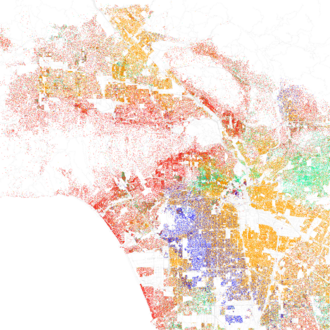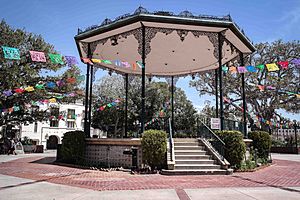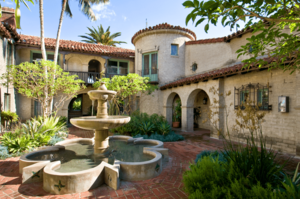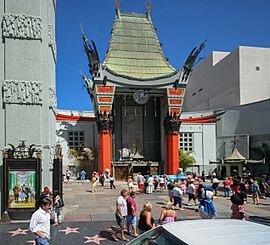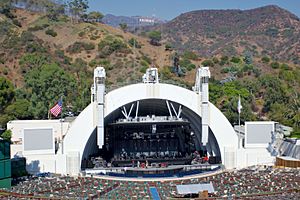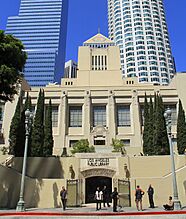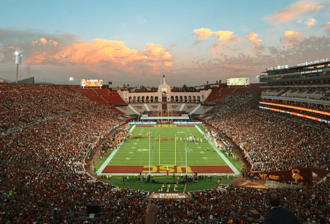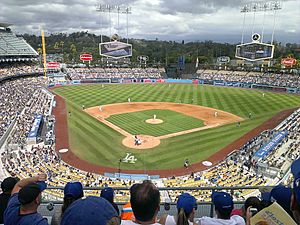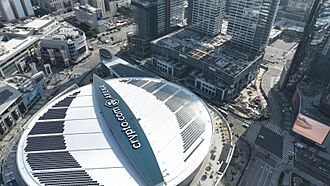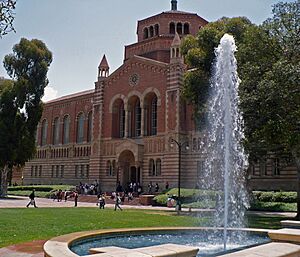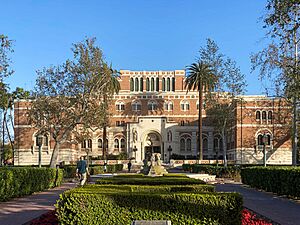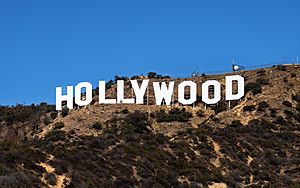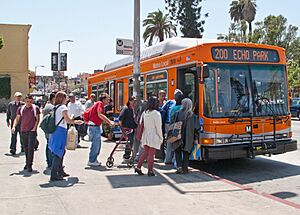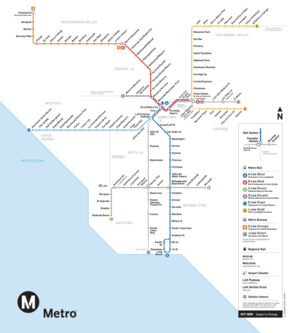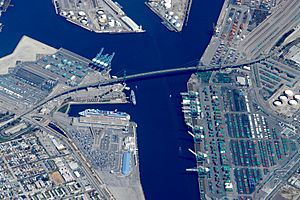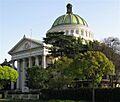Los Angeles facts for kids
Quick facts for kids
Los Angeles
|
|||||
|---|---|---|---|---|---|
|
|||||
| Nicknames:
L.A., City of Angels, The Entertainment Capital of the World, La-la-land, Tinseltown
|
|||||
| Country | United States | ||||
| State | California | ||||
| County | Los Angeles | ||||
| Region | Southern California | ||||
| CSA | Los Angeles-Long Beach | ||||
| MSA | Los Angeles-Long Beach-Anaheim | ||||
| Pueblo | September 4, 1781 | ||||
| City status | May 23, 1835 | ||||
| Incorporated | April 4, 1850 | ||||
| Named for | Our Lady, Queen of the Angels | ||||
| Government | |||||
| • Type | Mayor-council | ||||
| • Body | Los Angeles City Council | ||||
| Area | |||||
| • Total | 498.3 sq mi (1,290.6 km2) | ||||
| • Land | 469.1 sq mi (1,214.9 km2) | ||||
| • Water | 29.2 sq mi (75.7 km2) | ||||
| Elevation | 233 ft (71 m) | ||||
| Highest elevation | 5,075 ft (1,576 m) | ||||
| Lowest elevation | 0 ft (0 m) | ||||
| Population
(2020)
|
|||||
| • Total | 3,898,747 | ||||
| • Estimate
(2023)
|
3,820,914 | ||||
| • Rank | 3rd in North America 2nd in the United States 1st in California |
||||
| • Density | 8,205/sq mi (3,168/km2) | ||||
| • Urban | 12,237,376 (US: 2nd) | ||||
| • Metro | 12,799,100 (US: 2nd) | ||||
| • CSA | 18,316,743 (US: 2nd) | ||||
| Demonyms | Angeleno, Angelino, Angeleño | ||||
| GDP | |||||
| • Metro | $1.295 trillion (2023) | ||||
| • CSA | $1.618 trillion (2023) | ||||
| Time zone | UTC−08:00 (PST) | ||||
| • Summer (DST) | UTC−07:00 (PDT) | ||||
| ZIP Codes |
List
90001–90084, 90086–90089, 90091, 90093–90097, 90099, 90101–90103, 90174, 90185, 90189, 90291–90293, 91040–91043, 91303–91308, 91311, 91316, 91324–91328, 91330, 91331, 91335, 91340, 91342–91349, 91352–91353, 91356–91357, 91364–91367, 91401–91499, 91504–91505, 91601–91609
|
||||
| Area codes | 213, 323, 310, 424, 818, 747, 626 | ||||
| FIPS code | 06-44000 | ||||
| GNIS feature IDs | 1662328, 2410877 | ||||
Los Angeles, often called L.A., is the biggest city in California. With over 3.8 million people, it's the second-largest city in the United States, right after New York City. L.A. is a major center for business, money, and culture in Southern California. It's known for having people from many different backgrounds and cultures.
Most of Los Angeles is in a flat area called a basin, near the Pacific Ocean. It also stretches into the Santa Monica Mountains and the San Fernando Valley. The city covers about 469 square miles and is the main city of Los Angeles County. This county is the most populated in the U.S. with nearly 10 million residents. L.A. is also the third most visited city in the U.S.
The land where Los Angeles now stands was first home to the Tongva people. In 1542, Juan Rodríguez Cabrillo claimed the area for Spain. The city was officially started on September 4, 1781. It was called "El Pueblo de Nuestra Señora la Reina de los Ángeles," which means "The Town of Our Lady the Queen of the Angels."
After the Mexican War of Independence in 1821, Los Angeles became part of Mexico. Then, in 1848, after the Mexican–American War, it became part of the United States. Los Angeles officially became a city on April 4, 1850. The discovery of oil in the 1890s and the building of the Los Angeles Aqueduct in 1913 helped the city grow very quickly.
Los Angeles has a strong economy with many different industries. It's a huge center for making movies and TV shows, even though some production has moved away. The city also has one of the busiest ports in the Americas. In 2018, the Los Angeles area had a huge economy, making it one of the largest in the world. Los Angeles hosted the Summer Olympics in 1932 and 1984, and will host them again in 2028.
Contents
History of Los Angeles
Early History and Spanish Rule
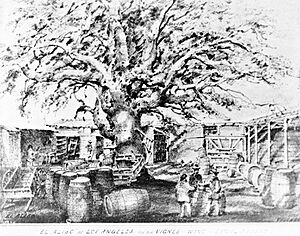
Long ago, the Tongva people lived in the area that is now Los Angeles. Their main village was called Yaanga. In 1542, a Spanish explorer named Juan Rodríguez Cabrillo claimed this land for Spain.
Later, in 1769, Gaspar de Portolà and a missionary named Juan Crespí arrived. In 1771, Junípero Serra helped build the Mission San Gabriel Arcángel. On September 4, 1781, a group of 44 settlers founded a town called "El Pueblo de Nuestra Señora la Reina de los Ángeles." This means "The Town of Our Lady the Queen of the Angels."
Mexican Rule and American Takeover
In 1821, Mexico became independent from Spain, and Los Angeles became part of Mexico. During this time, Pío Pico, a Mexican governor, made Los Angeles the capital of Alta California.
In 1846, during the Mexican–American War, American marines took control of the town. After some fighting, the Treaty of Cahuenga was signed in 1847. This agreement, along with the Treaty of Guadalupe Hidalgo in 1848, officially made Los Angeles and the rest of California part of the United States.
Growth and Development in the U.S.
Los Angeles officially became a city on April 4, 1850. Railroads arrived in the late 1800s, connecting the city to the rest of the country. In 1892, oil was discovered, which led to fast growth. By 1923, California was the biggest oil producer in the U.S.
By 1900, Los Angeles had over 102,000 people. To support this growth, the Los Angeles Aqueduct was finished in 1913. This brought water from Eastern California and helped the city expand even more.

In 1910, Hollywood joined Los Angeles. By 1921, most of the world's film industry was in L.A. This industry helped the city avoid many problems during the Great Depression. By 1930, the population reached over one million. Los Angeles hosted the 1932 Summer Olympics that year.
Post-World War II Era
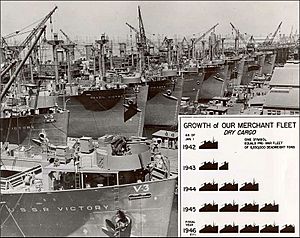
During World War II, Los Angeles became a big center for making things for the war, like ships and airplanes. Many aircraft companies were based here. After the war, Los Angeles grew even faster, spreading out into the San Fernando Valley. New highways built in the 1950s and 1960s helped this growth.
In 1969, the first ARPANET transmission, which led to the internet, was sent from University of California, Los Angeles (UCLA). In 1973, Tom Bradley became the city's first African American mayor. He served for five terms.
In 1984, Los Angeles hosted the 1984 Summer Olympics for the second time. These games were very successful financially. In 1994, a big earthquake, the Northridge earthquake, caused a lot of damage and some deaths.
Los Angeles in the 21st Century
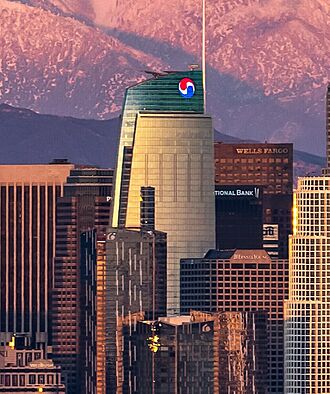
In 2002, voters decided against parts of the city, like the San Fernando Valley, becoming separate cities. In 2022, Karen Bass became the first female mayor of Los Angeles.
Los Angeles will host the 2028 Summer Olympics and Paralympic Games. This will make it the third city to host the Olympics three times.
Geography and Environment
Los Angeles Topography
The city of Los Angeles covers about 502.7 square miles. It stretches for 44 miles from north to south and 29 miles from east to west. The city has both flat areas and hills.
The highest point in Los Angeles is Mount Lukens, which is 5,074 feet tall. It's in the foothills of the San Gabriel Mountains. The eastern part of the Santa Monica Mountains goes from Downtown to the Pacific Ocean. It separates the Los Angeles Basin from the San Fernando Valley.
Other hilly areas include Mt. Washington and parts of Boyle Heights. The San Gabriel Mountains are just north of the city and are a popular place for outdoor activities.
The Los Angeles River is the main waterway. It was straightened and lined with concrete to help control floods. The river starts in Canoga Park and flows south through the city center to the Port of Long Beach.
Plants and Animals in Los Angeles

Los Angeles has many native plants because of its different environments, like beaches, wetlands, and mountains. Common plants include California poppy, chaparral shrubs, and riparian woodland trees. Some native plants, like the Los Angeles sunflower, are now very rare.
Many types of palm trees grow in Los Angeles, but only the California Fan Palm is native to California. The official tree of Los Angeles is the Coral Tree. The official flower is the Bird of Paradise, and the official plant is toyon.
The city also has a population of bobcats. These wild cats sometimes have a skin problem called mange.
Earthquakes and Geology
Los Angeles is located in an area with many earthquakes because it's on the Pacific Ring of Fire. About 10,000 earthquakes happen in Southern California each year, but most are too small to feel. The San Andreas Fault system, a major fault line, runs through the area. Scientists warn about a "big one" because the last major earthquake on this fault was in 1857.
Major earthquakes that have affected Los Angeles include the 1933 Long Beach, 1971 San Fernando, 1987 Whittier Narrows, and 1994 Northridge earthquakes. Parts of the city can also be affected by tsunamis from faraway earthquakes.
City Layout and Buildings
Los Angeles is made up of many different districts and neighborhoods. Many of these used to be separate cities that later joined Los Angeles. The city has signs to mark almost all of them.
The streets usually follow a grid pattern, but hills and valleys make it more complex. Major streets are very long and help traffic move through the city. For example, Sepulveda Boulevard is 43 miles long. Los Angeles drivers spend a lot of time in traffic, especially during rush hour.
Los Angeles is known for its low-rise buildings. Unlike New York City, tall skyscrapers are not common everywhere. However, Downtown has many tall buildings, including the Wilshire Grand Center, which is the tallest building in California.
- Selection of neighborhoods in Los Angeles
Los Angeles Climate
Los Angeles has a climate with dry summers and very mild winters. Daytime temperatures are usually comfortable all year. In winter, they average around 68°F (20°C). Autumn can be hot, with heat waves in September and October.
Los Angeles gets a lot of sunshine, with only about 35 days of rain each year. Temperatures can change a lot between day and night, especially inland. The ocean water averages 63°F (17°C).
Because of the mountains, Los Angeles has many different small climates. For example, in July, the average high temperature at Santa Monica Pier is 70°F (21°C), but it's 95°F (35°C) in Canoga Park, which is only 15 miles away.
Rainfall mostly happens between November and March. Summers are usually dry. Freezing temperatures and snow are very rare in the city center and along the coast. The last time it froze downtown was in 1979. Snowfall in the mountains within city limits happens every winter.
Sometimes, hot, dry Santa Ana winds blow through Los Angeles in autumn and winter. These winds can increase the risk of wildfires.
Environmental Concerns
Los Angeles has air pollution, known as smog. This is because of its geography, many cars, and busy ports. The Los Angeles Basin traps exhaust from vehicles, ships, and factories.
The smog season usually lasts from May to October. Since Los Angeles doesn't get much rain, pollution can build up for many days. Laws like the Clean Air Act were created to help with air quality. California has also worked to reduce pollution by requiring low-emission vehicles.
The number of serious smog alerts has dropped a lot since the 1970s. However, Los Angeles is still ranked as one of the most polluted cities for particle pollution. The city aims to get more of its power from renewable sources.
Los Angeles also has many active oil wells near homes, schools, and hospitals. This is a concern for the environment.
People and Culture
Population and Diversity
Los Angeles is a very diverse city. In 2010, it had a population of about 3.8 million people. The city is home to people from over 140 countries who speak 224 different languages.
Many different ethnic groups live in Los Angeles. There are areas known as ethnic enclaves like Chinatown, Koreatown, Little Armenia, and Little Tokyo. These areas show how many different cultures live in Los Angeles.
The largest Hispanic group is of Mexican background, making up about 31.9% of the city's population. Many Hispanic residents live in areas like East Los Angeles and Westlake.
The largest Asian groups are Filipinos and Koreans. Chinese people mostly live outside the city in the San Gabriel Valley. Japanese people have a community in Little Tokyo.
African Americans are a large group in South Los Angeles, in neighborhoods like Crenshaw and Watts. Los Angeles has the second-largest Mexican, Armenian, Salvadoran, Filipino, and Guatemalan populations in the world. It also has the largest Japanese, Iranian, Cambodian, and Romani populations in the U.S.
Most foreign-born people in Los Angeles come from Mexico, El Salvador, Guatemala, the Philippines, and South Korea.
Religious Beliefs in Los Angeles

Christianity is the most common religion in Los Angeles, with about 65% of people identifying as Christian. The Roman Catholic Archdiocese of Los Angeles is the largest Catholic archdiocese in the country.
Los Angeles has the second-largest Jewish population in the United States, after New York City. Many Jewish people live on the Westside and in the San Fernando Valley.
The International Church of the Foursquare Gospel was started in Los Angeles in 1923. Many different types of Protestant churches have also been important in the city's history.
The Los Angeles California Temple, a large temple for the Church of Jesus Christ of Latter-day Saints, is in the Westwood neighborhood.
Because of its diverse population, many other faiths are practiced in Los Angeles. These include Buddhism, Hinduism, Islam, Zoroastrianism, and Sikhism.
Homelessness in Los Angeles
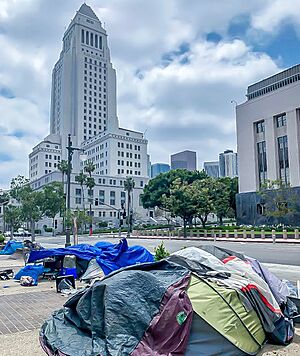
In January 2020, there were over 41,000 homeless people in Los Angeles. This is about 62% of all homeless people in Los Angeles County. The Skid Row neighborhood has one of the largest groups of homeless people in the U.S.
The increase in homelessness is partly due to housing being too expensive. Many people who became homeless said it was because of money problems. Black people are much more likely to experience homelessness in Los Angeles.
Economy and Industries
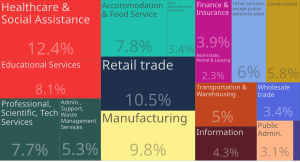
Los Angeles has a strong economy driven by many different things. These include international trade, entertainment (movies, TV, music, video games), aerospace, technology, oil, fashion, and tourism. Other important industries are finance, healthcare, and transportation.
Los Angeles is one of the biggest centers for making movies in the world. Only one of the five major film studios, Paramount Pictures, is actually inside the city limits.
Los Angeles is also the largest manufacturing center in the United States. The Port of Los Angeles and Port of Long Beach together form one of the busiest ports in the world. This port is very important for trade with countries around the Pacific Ocean.

The Los Angeles area has a huge economy, making it the third-largest in the world, after New York and Tokyo. Los Angeles is considered an "alpha world city," meaning it's very important globally.
Many big companies have their headquarters in Los Angeles or the surrounding area. These include AECOM, CBRE Group, The Walt Disney Company, Universal Pictures, and Warner Bros..
Arts and Culture
Los Angeles is often called the "creative capital of the world." Many artists, writers, filmmakers, actors, dancers, and musicians live and work here. The city's culture is also strongly influenced by Mexican American history. Los Angeles is famous for its many colorful murals.
Famous Landmarks and Architecture
The buildings in Los Angeles show its Spanish, Mexican, and American past. Popular styles include Spanish Colonial Revival, Art Deco, and Mid-Century Modern.
Some important landmarks are the Hollywood Sign, Walt Disney Concert Hall, Griffith Observatory, Getty Center, Grauman's Chinese Theatre, and Los Angeles City Hall. Other famous places include Venice Canal Historic District, Bradbury Building, and Olvera Street.
Movies and Live Performances
Live performances are a big part of Los Angeles's culture. There are over 1,100 theater shows each year. The Los Angeles Music Center is one of the largest performing arts centers in the U.S. It hosts the famous Los Angeles Philharmonic orchestra.
The Hollywood neighborhood is known worldwide as the center of the movie and TV industry. Many major film studios and record labels are here. Los Angeles also hosts big awards shows like the Academy Awards (Oscars) and the Grammy Awards. The USC School of Cinematic Arts is the oldest film school in the U.S.
Museums and Art Galleries
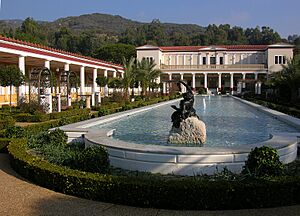
Los Angeles County has 841 museums and art galleries. This is more museums per person than any other U.S. city. Some famous museums include the Los Angeles County Museum of Art (the biggest art museum in the Western U.S.), the Getty Center, the Petersen Automotive Museum, and The Broad. Many art galleries are on Gallery Row in Downtown Los Angeles.
Libraries and Food
The Los Angeles Public Library system has 72 public libraries. The food culture in Los Angeles mixes different global cuisines because of its many immigrant communities. You can find amazing Mexican food from food trucks and restaurants. There are also many Asian restaurants, especially in Chinatown, Koreatown, and Little Tokyo. Los Angeles also has many vegan and vegetarian options.
Sports in Los Angeles
Los Angeles and its surrounding area are home to many professional sports teams. These include:
- Los Angeles Dodgers (baseball)
- Los Angeles Angels (baseball)
- Los Angeles Rams (football)
- Los Angeles Chargers (football)
- Los Angeles Lakers (basketball)
- Los Angeles Clippers (basketball)
- Los Angeles Kings (hockey)
- Anaheim Ducks (hockey)
- Los Angeles Galaxy (soccer)
- Los Angeles FC (soccer)
- Los Angeles Sparks (women's basketball)
The city also has popular college sports teams, like the UCLA Bruins and the USC Trojans.
Los Angeles has hosted the Summer Olympic Games twice, in 1932 and 1984. It will host them again in 2028, making it one of only three cities to host the Olympics three times.
The city has many sports venues, such as Dodger Stadium, the Los Angeles Memorial Coliseum, and Crypto.com Arena. Nearby cities also have venues like the Rose Bowl and SoFi Stadium.
The Rose Bowl has hosted five Super Bowls and the 1994 FIFA World Cup Final. It also hosts the annual Rose Bowl college football game. Los Angeles will be a host city for the 2026 FIFA World Cup.
Los Angeles is one of only six North American cities to have won championships in all five major sports leagues (baseball, football, hockey, basketball, and soccer).
Education in Los Angeles
Colleges and Universities
Los Angeles has three public universities:
- California State University, Los Angeles (CSULA)
- California State University, Northridge (CSUN)
- University of California, Los Angeles (UCLA)
There are also many private colleges in the city, including:
- American Film Institute Conservatory
- Loyola Marymount University (LMU)
- Occidental College ("Oxy")
- University of Southern California (USC)
The city also has a system of nine community colleges:
- East Los Angeles College (ELAC)
- Los Angeles City College (LACC)
- Los Angeles Harbor College
- Los Angeles Mission College
- Los Angeles Pierce College
- Los Angeles Valley College (LAVC)
- Los Angeles Southwest College
- Los Angeles Trade-Technical College
- West Los Angeles College
Schools in Los Angeles
The Los Angeles Unified School District (LAUSD) serves most of the city. It is one of the largest school districts in the U.S., with about 800,000 students. LAUSD has many Magnet schools that offer special programs.
Media and News
Los Angeles is the second-largest media market in the U.S., after New York. This means many TV and radio stations serve the area.
The main daily English newspaper is the Los Angeles Times. La Opinión is the main Spanish newspaper. There are also newspapers in Korean and Chinese. The Los Angeles Sentinel is a major African-American weekly paper.
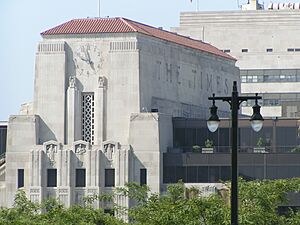
Many major TV networks like ABC, CBS, FOX, and NBC have production facilities and offices in Los Angeles. They also have their main West Coast TV stations here.
There are also many smaller local newspapers, magazines, and online guides that cover news, arts, and culture in Los Angeles.
Transportation in Los Angeles
Freeways and Roads
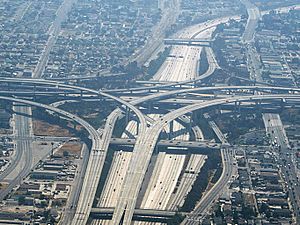
Los Angeles has a huge network of freeways and highways. In 2019, Los Angeles roads were ranked the most congested in the U.S. Drivers spent an average of 119 extra hours in traffic that year. However, the average daily commute time is shorter than in some other big cities.
Major highways connecting L.A. to other parts of the country include Interstate 5 (running north-south) and Interstate 10 (running east-west across the country).
Buses and Public Transit
The Los Angeles County Metropolitan Transportation Authority (LACMTA), also called Metro, runs a large bus system. The Los Angeles Metro Bus system has 117 routes that cover Los Angeles and nearby cities. Metro also has two bus rapid transit lines, the G and J lines, which are like light rail.
Other bus systems serve specific areas, like the Big Blue Bus in Santa Monica. You can pay for buses with a TAP card. About 9.2% of working residents use public transportation to get to work.
Trains and Rail System
Metro also operates a subway and light rail system called Los Angeles Metro Rail. It includes the B and D subway lines, and the A, C, E, and K light rail lines. You need a TAP card for all Metro Rail trips.
The Metro Rail system has grown a lot since it opened in 1990. Today, it covers over 107 miles of rail and has 101 stations. It serves areas like Long Beach, Pasadena, Santa Monica, and downtown Los Angeles.
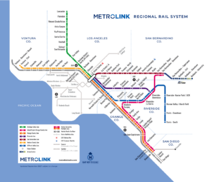
Los Angeles is also the center for Metrolink, a commuter train system. It connects Los Angeles to other counties like Ventura and Orange. Metrolink has eight lines and 69 stations.
Amtrak also provides intercity passenger trains from Los Angeles to other cities. The Pacific Surfliner route is one of Amtrak's busiest lines.
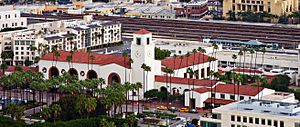
The main train station in the city is Union Station, which opened in 1939. It's the largest passenger train station in the Western U.S. Union Station is a major hub for Amtrak, Metrolink, and Metro Rail.
Airports and Seaports
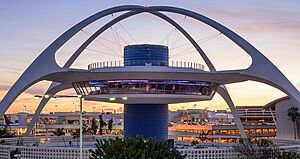
The main airport for Los Angeles is Los Angeles International Airport, known as LAX. It's on the Westside of Los Angeles.
Other major airports nearby include:
- Ontario International Airport (serves the Inland Empire)
- Hollywood Burbank Airport (closest to downtown Los Angeles)
- Long Beach Airport
- John Wayne Airport (in Orange County)
The Port of Los Angeles is in the San Pedro neighborhood. It's about 20 miles south of Downtown. This port, along with the Port of Long Beach, forms one of the busiest container ports in the world. The Port of Los Angeles is also the largest cruise ship center on the West Coast.
Sister Cities
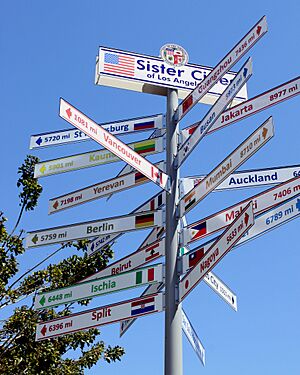
Los Angeles has 25 sister cities around the world. These are cities that have special partnerships with Los Angeles to promote cultural and economic ties.
- Eilat, Israel (1959)
- Nagoya, Japan (1959)
- Salvador, Brazil (1962)
- Bordeaux, France (1964)
- Berlin, Germany (1967)
- Lusaka, Zambia (1968)
- Mexico City, Mexico (1969)
- Auckland, New Zealand (1971)
- Busan, South Korea (1971)
- Mumbai, India (1972)
- Tehran, Iran (1972)
- Taipei, Taiwan (1979)
- Guangzhou, China (1981)
- Athens, Greece (1984)
- Saint Petersburg, Russia (1984)
- Vancouver, Canada (1986)
- Giza, Egypt (1989)
- Jakarta, Indonesia (1990)
- Kaunas, Lithuania (1991)
- Makati, Philippines (1992)
- Split, Croatia (1993)
- San Salvador, El Salvador (2005)
- Beirut, Lebanon (2006)
- Ischia, Campania, Italy (2006)
- Yerevan, Armenia (2007)
Los Angeles also has "friendship cities":
- Łódź, Poland
- City of Melbourne, Australia
- Manchester, United Kingdom
- Tel Aviv, Israel
Images for kids
-
The Spanish founded Mission San Fernando Rey de España in 1797.
-
Paramount Pictures Studios.
-
BMO Stadium, home of Los Angeles FC of Major League Soccer.
See also
 In Spanish: Los Ángeles para niños
In Spanish: Los Ángeles para niños


